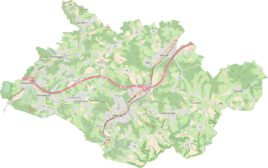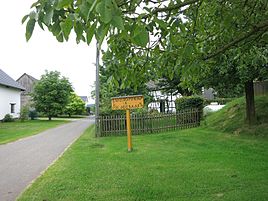Blindenaaf
|
Blindenaaf
City of Overath
Coordinates: 50 ° 55 ′ 10 ″ N , 7 ° 18 ′ 58 ″ E
|
||
|---|---|---|
| Height : | 225 m | |
|
Location of Blindenaaf in Overath |
||
Blindenaaf is a district of Marialinden in the town of Overath in the Rheinisch-Bergisches Kreis in North Rhine-Westphalia , Germany .
description
Blindenaaf is located southeast of Overath and southwest of Marialinden on a hill. The R. Naafbach continues to flow south, is at its course of living space Blindenaafermühle who was counted in the 19th century to Blindenaaf.
In the vernacular, the place was called om blengen Ovven (= on the blind stove). In the past, a racing fire is said to have burned in a pit in which iron was melted with charcoal . The fire on the heights could be seen from afar. When it went out, the stove was blind .
history
The place was first mentioned in a document in the 13th century as a blind ape . The defining word for the blind is derived from the fact that a watercourse that arises at the location seeps away again on a meadow before it flows into the Naafbach, i.e. it drains blindly . The brook name Naaf itself, called de Nafe in the 13th century , called the Nave in 1555 , is a river name word of Indo-European origin, the root of which cannot be traced in German . The meaning seems to be neutral flow and is related to the Greek nao (= flow ), Latin nato (= swimme ) , navis (= ship ).
The Topographia Ducatus Montani by Erich Philipp Ploennies , Blatt Amt Steinbach , shows that the residential area had four farms as early as 1715, which are labeled as Pliegenaaf . Carl Friedrich von Wiebeking names the court on his charter of the Duchy of Berg in 1789 as Bliedenaaf . It shows that the place was part of the Honschaft Burg in the parish of Overath at that time .
The place is recorded on the topographical survey of the Rhineland from 1817 as a blind stove . The Prussian first recording from 1845 shows the residential area under the name Blindenas . From the Prussian new admission of 1892, the place is regularly recorded on the measuring table as Blindenaaf .
In 1822, 34 people lived in the place categorized as Hof und Mühle (meaning the Blindenaafer Mühle), which after the collapse of the Napoleonic administration and its replacement, belonged to the Overath mayor in the Mülheim am Rhein district and was then called the Blindenofen . For the year 1830 a total of 40 inhabitants are given for the place called Blindenofen , which is called a farm with a mill . The Blindenaf , which was also categorized as a farm and mill according to the survey of the government district of Cologne in 1845 , had eleven residential buildings with 68 inhabitants at that time, all of them Catholic denominations. The Blindenaafer mill was also added to the place. The local and Gutbezirksstatistik the Rhine Province leads Blindenaaf alone in 1871 with 16 houses and 73 on population. In the municipality lexicon for the Rhineland province of 1888, 15 houses with 53 inhabitants are given, now without the Blindenaafermühle. In 1895 the place had nine houses with 44 inhabitants, in 1905 seven houses and 22 inhabitants are given.
Individual evidence
- ^ Franz Becher: 900 years of Overath . Ed .: Bergischer Geschichtsverein Overath e. V. Bücken & Sulzer Verlag GbR, Overath 2005, ISBN 3-936405-28-X . , Page 230
- ^ A b c Heinrich Dittmaier : Settlement names and settlement history of the Bergisches Land . In: Journal of the Bergisches Geschichtsverein . tape 74 , parallel edition as a publication by the Institute for Historical Regional Studies of the Rhineland at the University of Bonn. Schmidt, Neustadt ad Aisch 1956.
- ^ Wilhelm Fabricius : Explanations for the Historical Atlas of the Rhine Province ; Second volume: The map of 1789. Division and development of the territories from 1600 to 1794 ; Bonn; 1898
- ↑ Alexander A. Mützell: New topographical-statistical-geographical dictionary of the Prussian state . tape 1 . Karl August Künnel, Halle 1821.
- ↑ Friedrich von Restorff : Topographical-statistical description of the Royal Prussian Rhine Province , Nicolai, Berlin and Stettin 1830
- ↑ Overview of the components and list of all the localities and individually named properties of the government district of Cologne: by districts, mayor's offices and parishes, with information on the number of people and the residential buildings, as well as the Confessions, Jurisdictions, Military and former state conditions. / ed. from the Royal Government of Cologne [Cologne], [1845]
- ↑ Royal Statistical Bureau Prussia (ed.): The communities and manor districts of the Prussian state and their population . The Rhine Province, No. XI . Berlin 1874.
- ↑ Königliches Statistisches Bureau (Prussia) (Ed.): Community encyclopedia for the Rhineland Province, based on the materials of the census of December 1, 1885 and other official sources, (Community encyclopedia for the Kingdom of Prussia, Volume XII), Berlin 1888.
- ↑ Königliches Statistisches Bureau (Prussia) (Ed.): Community encyclopedia for the Rhineland Province, based on the materials of the census of December 1, 1895 and other official sources, (Community encyclopedia for the Kingdom of Prussia, Volume XII), Berlin 1897.
- ↑ Königliches Statistisches Bureau (Prussia) (Ed.): Community encyclopedia for the Rhineland Province, based on the materials of the census of December 1, 1905 and other official sources, (Community encyclopedia for the Kingdom of Prussia, Volume XII), Berlin 1909.


